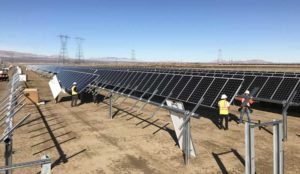 Once the engineering design for a solar photovoltaic (PV) project is completed, site preparation can begin. Site preparation includes establishing road access to the site, excavation, grading, installing drainage systems, and installing perimeter fencing. When site preparation is completed, engineers and contractors will begin installing the solar equipment.
Once the engineering design for a solar photovoltaic (PV) project is completed, site preparation can begin. Site preparation includes establishing road access to the site, excavation, grading, installing drainage systems, and installing perimeter fencing. When site preparation is completed, engineers and contractors will begin installing the solar equipment.
A PV system consists of PV cells, racking or mounting structure, electrical wiring and connections, mounting hardware, power-conditioning equipment (inverter), and conduit. The cells are mounted on racking structures that point them toward the sun. In cases where the tracking systems are installed, these mounts can turn to follow the sun, much like a sunflower, allowing the solar panel to remain optimally positioned to gather sunlight over the course of the day. These structures are connected to balance-of-system components that transmit electricity generated by the panels to the electric utility grid.
The first step in the installation of a solar PV system is to install these mounting structures. When the mounting structures are complete, the PV panels are attached with brackets. An electrical junction box on each PV panel is then connected to the circuit. While the electricity generated at a solar panel is direct current, the circuit includes an inverter that converts the direct-current power into alternating-current power that can be fed into the electric utility grid. Electrical cables are used to collect the electricity generated by each group of panels and transmit this electricity to the point of interconnection with the utility grid. Once all panels and balance-of-system equipment is installed, a connection is made to the grid and the system is energized.
